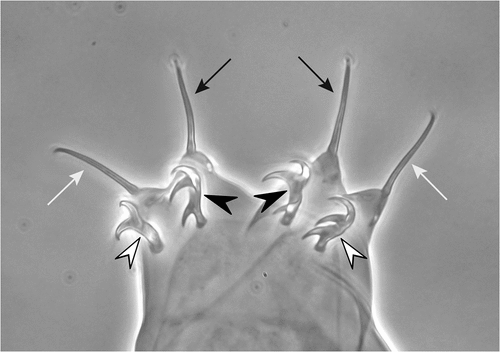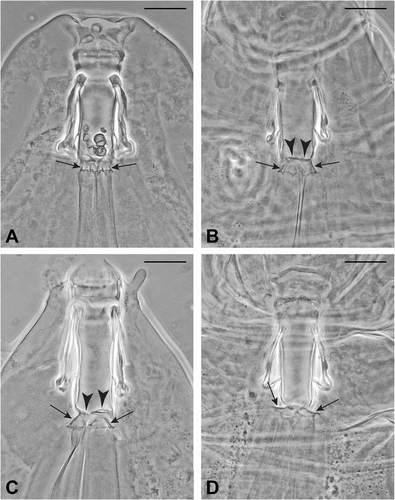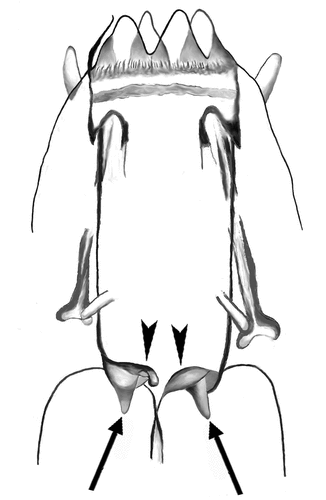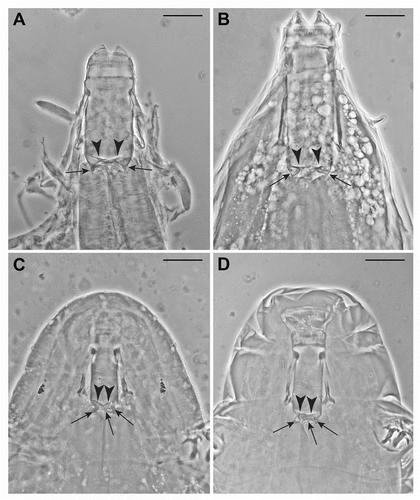Figures & data
Table I. Examined species of Milnesium deposited in the Pilato and Binda collection, with type specimens, if any, indicated (if none, the geographic provenance is given), slide numbers and number of specimens analysed. If not specified, specimens were of undetermined age and sex (likely females)
Table II. Species of Milnesium by valvular system type, with indication of examined specimens and/or figures (from the literature or the present paper) on which the system attribution is based. Types means holotype and paratypes; slide numbers are as indicated in
Table
Table III. Species of the genus Milnesium of which young and adult specimens, and/or males and females, have been observed (in the present study or the literature, as indicated). Types means holotype and paratypes; slide numbers are as indicated in
Table IV. Species with type 1 valvular system, correlated to body size, pt (= “percentual tube”, i.e. percentual ratio of the given structure with the buccal tube length (Pilato Citation1981)) of buccal tube standard width, and mounting medium. Data source indicates the literature sources and/or material examined by us (as indicated in ) to determine the valvular system type and obtain other data (body size, pt of buccal tube standard width, and mounting medium); the provided references are species’ original descriptions, or redescriptions (as specified), or refer to cultured strains (as specified). Body and buccal tube measurements, unless otherwise indicated, are from the corresponding cited literature source and refer to the specimen(s) with photograph(s) published in the same paper, in order to match the precise specimen with determined valvular system type, with its measurements; “our measurement(s)” refers to measurements taken by us on the previously indicated slide(s). Mounting media: AAF = fixed in acetic acid end mounted in Faure medium; Hoyer’s = Hoyer’s medium; PVA = polyvinyl alcohol; PVLF = polyvinyl lactophenol
Table V. Species with type 2 valvular system, correlated to body size, pt of buccal tube standard width, and mounting medium. Data source indicates literature sources and/or material examined by us (as indicated in ; types mean holotype and paratypes) to determine the valvular system type and obtain other data (body size, pt of buccal tube standard width, and mounting medium); the provided references are species’ original descriptions, or redescriptions (as specified). Body and buccal tube measurements, unless otherwise indicated, are from the corresponding cited literature source and refer to the specimen(s) with photograph(s) published in the same paper, in order to match the precise specimen with determined valvular system type, with its measurements; “our measurement(s)” refers to measurements taken by us on the previously indicated slide(s). Mounting media: AAF = fixed in acetic acid end mounted in Faure medium; Hoyer’s = Hoyer’s medium; PVA = polyvinyl alcohol; PVLF = polyvinyl lactophenol; “Polivinil” is what Ramazzotti, in 1962, wrote on his slides containing the type material of M. granulatum (the exact medium is unknown)
Figure 1. Claws of the hind legs of a Milnesium sp. to demonstrate the new nomenclature. Arrows: primary (or main) claws; arrowheads: secondary claws. Black arrows: posterior primary claws; white arrows: anterior primary claws; black arrowheads: posterior secondary claws; white arrowheads: anterior secondary claws. For legs I–III, “external” (or “lateral”) and “internal” (or “medial”), instead of “posterior” and “anterior”, will be used to indicate the single claws.

Figure 2. Valvular system of the tardigradum type (type 1); arrows indicate the cuticular folds in the tract connecting buccal tube and pharynx; arrowheads in (b) and (c) indicate the flaps. Scale bars: 20 µm. All slides deposited in the Pilato and Binda collection. (a) Paratype of Milnesium almatyense Tumanov (Citation2006) (Slide No. 5106). The flaps are not well visible while the flexible tract between buccal tube and pharyngeal bulb, with some folds (arrows), is well visible. (b) Valvular system of a specimen of the neotype series of Milnesium tardigradum Doyère (Citation1840) (Slide No. 5489). One flap (arrowhead) and the flexible tract between buccal tube and pharyngeal bulb, with some folds (arrows), are well visible. This flexible tract is caudally dilated the pharyngeal bulb being closer to the buccal tube than in (a). (c) Valvular system of a paratype of Milnesium inceptum Morek et al. (Citation2019) (Slide No. 5821). One flap (arrowhead) and the flexible tract between buccal tube and pharyngeal bulb, with some folds (arrows), are well visible. This flexible tract is caudally dilated, the pharyngeal bulb being closer to the buccal tube than in (a). (d) Valvular system of a specimen of the neotype series of Milnesium tardigradum Doyère (Citation1840) (Slide No. 5489). Two flaps (arrowheads) and the flexible tract between buccal tube and pharyngeal bulb, with some folds (arrows), are well visible. This flexible tract is caudally completely dilated, the pharyngeal bulb being pushed onto the buccal tube.

Figure 3. Valvular system of the shilohae type (type 2). Two flaps (arrowheads) and two conical thickenings (arrows) are visible, while the third ones are not in focus. The drawing (of Milnesium shilohae) is based on ) of Meyer (Citation2015).

Figure 4. (a–c). Valvular system of the shilohae type (type 2); arrows indicate the conical projections; arrowheads indicate the flaps. Scale bars: 20 µm. All slides deposited in the Pilato and Binda collection. (a) Holotype of Milnesium tetralamellatum Pilato and Binda (Citation1991) (Slide No. 3704). Two flaps (arrowheads) and two conical projections (arrows) are visible. The third ones are not in focus. (b) Holotype of Milnesium brachyungue Binda and Pilato (Citation1990) (Slide No. 3940). Two flaps (arrowheads) and two conical projections (arrows) are visible. The third ones are not in focus. (c) Specimen of Milnesium sp. 4 (Slide No. 5703). Two flaps (arrowhead) are clearly visible, and the three flexible conical projections (arrows) are partially visible, despite the partially reduced distance between buccal tube and pharyngeal bulb. (d) Paratype of Milnesium reticulatum Pilato et al. (Citation2002) (Slide No. 4851). Two flaps (arrowhead) are visible, and three flexible conical projections (arrows) are also visible (the third in the middle, barely) despite the reduced distance between buccal tube and pharyngeal bulb.

Table VI. Correlation between valvular system type (type 1 = tardigradum type; type 2 = shilohae type), eventual cuticular sculpture, number/configuration of the peribuccal lamellae, claw configuration, and ecozones in which each species results recorded. ° = species recorded in an ecozone different from that of the locus typicus. The fossil species M. swolenskyi has been excluded because it is not ecologically comparable with the other species’ actual zoogeography
